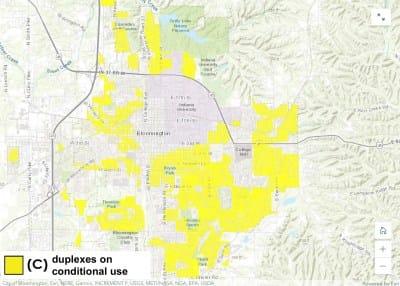Plex debate preview: “I would just ask everybody to come armed with patience.”

Bloomington’s plan commission has set up Thursday’s 5:30 p.m special session as a meeting dedicated to just one of 10 ordinances currently under consideration to amend the city’s unified development ordinance (UDO).

The ordinance would revise the way the UDO handles duplexes, triplexes and quadplexes—the so-called “plexes.”
One sign that Thursday’s public hearing is expected to be contentious was some encouragement on Monday from plan commission president Brad Wisler: “I would just ask everybody to come armed with patience.”
The plan commission normally allows five minutes to each public commenter. During discussion towards the end of Monday’s meeting, plan commissioners were inclined to allow the full five minutes at Thursday’s hearing. The other option batted around was to suspend the rules to reduce the time to three minutes.
In the current version of the UDO, no plexes are allowed at all in the R1 (residential large lot), R2 (residential medium lot) or R3 (residential small lot) zoning districts. That’s the result of a November 2019 vote taken by Bloomington’s city council, to remove even the conditional use of duplexes in those residential zoning districts.
The ordinance to be considered by the plan commission on Thursday would allow duplexes as a conditional use in R1, R2, R3, as well as in the new R4 (residential urban) district.
R4 has not yet been placed anywhere on the zoning map. R4 would also allow triplexes and quadplexes, but also just as conditional uses. The mapping of R4 is a step that will be handled in a separate ordinance, currently scheduled to be heard on Monday, March 29.
Conditional uses are allowed uses, but have to be approved by the city’s board of zoning appeals (BZA).
When the November 2019 vote was taken, just two councilmembers (Steve Volan and Jim Sims) opposed the prohibition of duplexes in R1, R2 and R3 districts. Weeks before the city council voted on the question, the plan commission had voted to recommend making duplexes a permitted (by-right) use, not just a conditional use. But that plan commission vote failed.
Compared to the planning staff’s proposal presented to the public in fall 2020, the current proposed ordinance is scaled down in its permissiveness of plexes.
The fall 2020 proposal would have allowed duplexes by right in R1 through R4. Under the fall 2020 proposal, triplexes and quadplexes would have also been allowed by right in R4. The scaling down of the proposal was the consequence of feedback from residents, which included commentary at city council meetings.
Arguments that have been made by supporters of plexes include: more compact built structures, which reduces energy use and greenhouse gas emissions; increases to housing supply, which pushes housing costs down and improves social equity; and improved feasibility of public transportation.
Arguments against allowing plexes include: concerns about the elimination of existing cheaper housing; the loss of the social fabric that ties single-family neighborhoods together; the lost benefits of owner-occupied housing; and conversion of single-family houses to multi-unit dwellings that send rent payments to out-of-town owners.
One factor that could mitigate against over-long debate on plexes by plan commissioners is that their recommendation to the city council is just that, a recommendation. The city council can amend the ordinance as it likes.
Still, plan commissioners have historically wanted to ensure that whatever they vote to recommend to the council is something they actually support.
And the state of the ordinance as recommended to the city council by the plan commission will have an impact on which city councilmembers will be prompted to craft amendments. Will the onus be on plex supporters, plex opponents, or both, to draft amendments for a council vote?
The proposed ordinance on plexes includes a couple of features that are meant to allay concerns about rapid wholesale conversion of big swaths of single-family owner-occupied housing into plexes used as rentals for possibly unruly tenants.
One ordinance feature is a provision that the owner or registered agent for the property cannot have a notice of violation (NOV) on file with the city’s housing and neighborhood development (HAND) department for three years before applying for a conditional use duplex in R1, R2, or R3 districts.
Another ordinance feature is that once a duplex is granted conditional use in R1, R2 or R3, a 150-foot buffer would be created around the approved duplex for two years. During those two years, no other duplexes could be approved in the buffer area.
In his Monday remarks about Thursday’s hearing on plexes, plan commission chair Brad Wisler asked members of the public to keep their remarks focused squarely on the topic of the ordinance about plexes. Wisler said, “We just have to ask everyone to keep their comments germane to the topic.” He added, “We want to make sure that everyone has a chance to get heard. And in order for that to happen, we need everyone to be respectful and stick to the topic at hand.”
On Monday, Susan Sandberg, who serves as the city council’s representative to the plan commission, called for civility in public commentary. “I would like to make an appeal right here and now to everyone in the public, who does wish to speak to this issue, that civility is so critically important.”
Sandberg asked commenters to be concise and to “keep it on the issues.” She added, “No name calling.”
Links to the Zoom video conference for Thursday’s (March 25) meeting and all the background material are available on the web page the planning staff has set up for the project.




Comments ()